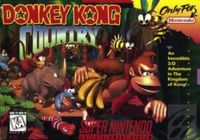Donkey Kong Country

| |
| Donkey Kong Country | |
| Developer | Rare |
| Publisher | Nintendo |
| System | Super Nintendo |
| Release Date | Super Nintendo EU November 24, 1994 US November 25, 1994 JP November 26, 1994 Gameboy Color US November 4, 2000 EU November 17, 2000 JP January 21, 2001 Gameboy Advance EU June 6, 2003 NA June 9, 2003 JP December 12, 2003 Virtual Console AU December 7, 2006 EU December 8, 2006 JP December 12, 2006 US February 19, 2007 |
| Gallery | GH Gallery |
| Rating | ESRB: E |
Donkey Kong Country was considered a revolutionary game at it's time. This was mostly due to it's prerendered 3D graphics.
This was also the first Donkey Kong game that Shigeru Miyamoto wasn't in charge of. He was critical of the game, saying "Donkey Kong Country proves that players will put up with mediocre gameplay as long as the art is good." He later apologized, saying he was too harsh due to Nintendo pressuring him to make Super Mario World 2: Yoshi's Island more like Donkey Kong Country.
Story
King K. Rool and the Kremlings have stolen Donkey Kong's banana hoard. With the help of his nephew, Diddy Kong, Donkey Kong must recover his bananas.
Gameplay
Though mostly a typical platformer, Donkey Kong Country had several unique features. The one that stands out most is the player being given two characters: Donkey Kong and Diddy Kong. Donkey Kong was the stronger of the two while Diddy Kong was quicker and more agile.
As well as two main characters, there were also a variety of animal helpers as well. Among them were Rambi the Rhino, Expresso the Ostrich, Enguarde the Swordfish, Winky the Frog, and Squawks the Parrot. Each had unique abilities to help the player through the level.
The game was made up of six worlds. The goal of each level was simply to reach the end while gathering all 100 bananas. Enemies blocked the way, but could be defeated bu jumping on them, throwing barrels at them, or rolling into them.
Continuity Notes
- The game has several callbacks to the arcade Donkey Kong. Additionally, Cranky Kong is referred to as having been the original Donkey Kong who battled Mario in "several of his own games" (the Donkey Kong arcade series, even though he instead fought Stanley in Donkey Kong 3), with the implication that this Donkey Kong is his son (an adult Donkey Kong Jr.) or grandson. The instruction manual clearly states that the Donkey Kong featured from Country onwards is "a totally new character" who is a "relative of the classic arcade character", although later games would be inconsistent about this point.
- As part of the debate over whether Donkey Kong is Cranky Kong's son or grandson, in the instruction manual Cranky is referred to as his granddad and "his old pappy" (which could mean father or grandfather, but most usually refers to a grandfather).
Legacy
Sequels
The next game in the Donkey Kong Country series was Donkey Kong Country 2: Diddy's Kong Quest.
Ports and Remakes
- Donkey Kong Country: Competition Cartridge was also for the Super Nintendo. It contained a shortened version of the game used for competition. On 2,500 copies were made.
- In 2000, the game was ported to the Gameboy Color.
- In 2003, the game was released on the Gameboy Advance.
- In 2006, Donkey Kong Country was made available for download on the Virtual Console.
See Also
- Enemies in Donkey Kong Country
- Worlds and Stages in Donkey Kong Country
- Donkey Kong web games versions of donkey kong country
| Titles in the Donkey Kong Series |
|---|
| Donkey Kong (GB) - Jr. - Math - 3 Donkey Kong Country (2: Diddy Kong's Quest - 3: Dixie Kong's Double Trouble) - Land (2 - III) - Donkey Kong 64 Mario vs. Donkey Kong - March of the Minis - Minis March Again! - Mini-Land Mayhem! - Minis on the Move - Tipping Stars Jungle Beat - King of Swing - Jungle Climber - Returns - Tropical Freeze Diddy Kong Racing - Donkey Konga (2 - 3) - Barrel Blast |